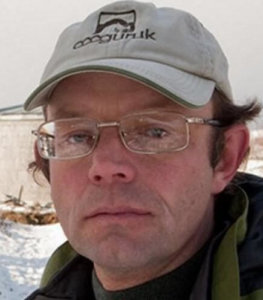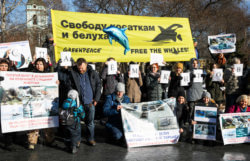The Whale Sanctuary Project is organizing a team of experts to go to Russia and assess the condition of 10 orca and 87 beluga whales being held in small pens there. (See our earlier post.) Here is some background.
Video from National Geographic, with comments from Jeff Foster of the Whale Sanctuary Project.
Last November, reports began to emerge that more than 100 orcas and beluga whales had been captured and were being held in small, crowded pens in Srednyaya Bay on Russia’s far east coast.
Local media were calling the facility a “whale jail,” and the term quickly went viral.
As winter set in and temperatures began to plummet, especially during the long nights, ice covered the bay, and it was a challenge simply to keep the sea pens free of ice so the whales could breathe, let alone get the exercise they would need to be able to keep warm. Having conducted the successful return of a captive orca to his home waters, we would like to offer the Russian government and the Russian scientific community our expertise and help in restoring the current captive orcas and beluga whales, now being held in series of sea pens in Srednyaya Bay, near the east coast city of Nakhodka, to their home pods.
According to the newspaper Novaya Gazeta, some of the animals had been at the facility since July and were owned by four companies – Bely Kit, Afalina, Oceanarium DV, and Sochi Dolphinarium – that had worked together between 2013 and 2016 to ship 13 orcas to China, where a single orca can fetch more than $6 million.
While Russian law allows for whales to be held for scientific and educational purposes, the whales in Srednyaya Bay were clearly destined for neighboring China, where there are already at least 76 dolphinariums and marine parks, and at least 25 more planned for construction over the next few years. Approximately 954 cetaceans (whales, dolphins and porpoises), of at least 12 species, are currently displayed in China. Most of them were captured from the wild and imported, primarily from Japan and Russia.
There were also reports of what appeared to be a whale being lifted out of a tank by a crane near the Chinese border, of a scam by which whales were being “loaned” rather than sold to evade environmental laws, and of a photographer having her camera’s memory card taken when she tried to investigate.
Video from Pravda describing the condition of the whales.
In December, after three of the belugas had disappeared and were widely assumed to have died, Kremlin spokesman Dmitry Peskov asked the new Governor of the Primorsky Region, Oleg Kozhemyako, to address the problem. Soon after, the Prosecutor General’s Office began an investigation into “the illicit extraction of aquatic biological resources” and into criminal “cruelty to animals.”
In January of this year, a group of Russian scientists and government officials visited the whale jail, where they collected skin and breath samples and water samples from the pens. They also made recordings of vocalizations and took photos and video footage.
Mark Palmer of the International Marine Mammal Project wrote that the scientists had expressed “a great deal of concern … for one of the orcas that appeared lethargic and was logging at the surface. Many of the orcas showed skin damage, presumably from frostbite and contact with the sharp ice that forms in the sea pens, despite the efforts of the staff of the sea pens to keep the pens clear of ice … The team also noted that the facility had no means of dealing with sanitary conditions, as the sea pens are exposed to bay water and lacked any barriers or means of disinfecting in case of disease or pollution.”


Tatiana Denisenko and Dmitry Lisitsyn
Among the scientists who visited the whales were Dmitry Lisitsyn, head of the Russian NGO Sakhalin Environment Watch, and veterinarian Tatyana Denisenko, a professor at the Moscow-based Academy of Veterinary Medicine and Biotechnology. Lisitsyn told National Geographic that the belugas all appeared to be in distress and that 15 of them were babies who had probably not yet been weaned from their mothers’ milk when they had been captured. He added that workers at the sea pens had to keep breaking up ice so the animals could surface in order to breathe and stay alive.
Belugas are “used to living in ice,” he said. “But they’re not used to being held in a 12-by-10-meter [space] with men crashing shovels over their heads.”
As for the orcas, Lisitsyn said their condition was even worse than that of the belugas since they typically migrate south to warmer water during the winter. His video footage showed skin lesions on and around their dorsal fins, which, he said, could be frostbite from exposure to prolonged cold, or a fungal or bacterial infection stemming from the stagnant water, or both.
After examining skin samples from the orcas, veterinarian Denisenko said, “The skin of most of the 11 killer whales is thickly seeded with various microorganisms.” She concluded from this that their skin infection was likely the result of rotting food being left in the pens.
Denisenko, Lisitsyn and others said they were particularly concerned about one young orca named Kirill, who had been acting very lethargically and exhibited extensive skin lesions. Lisitsyn said he feared Kirill might already be dead.
Within a few weeks of the scientists’ visit, one of the orcas was no longer to be seen in any of the sea pens. The whales’ captors claimed that he/she had escaped, an explanation that was generally considered absurd.

In Moscow, members of Greenpeace Russia protest the capture of the whales.
Despite the poor condition of the whales, scientists who reviewed the reports and video footage concluded that after receiving the urgent care they obviously need, they could still be returned to the ocean. Time, however, would be of the essence in conducting a successful return of the whales to their home waters.

Vladimir Putin with Leonardo DiCaprio at the Kremlin.
Meanwhile, protests were growing in animal protection circles around the world. By early March, a petition on Change.org that was being promoted by celebrities including Leonardo DiCaprio and Pamela Anderson had garnered more than a million signatures. (Russia’s President Vladimir Putin considers DiCaprio a friend, having welcomed him to Russia in 2010 to speak at his Save the Tiger Summit.)
And a letter to President Putin from explorer and environmentalist Jean-Michel Cousteau, Charles Vinick of the Whale Sanctuary Project, David Phillips of Earth Island Institute, and Roger Payne of Ocean Alliance had prompted an invitation from the Governor of Primorsky Region for Cousteau to come to the region.
Cousteau had already worked with Vinick on many projects on behalf of marine life, with Vinick serving for more than 25 years as Vice President of Ocean Futures Society and the Cousteau Society. So, they began to organize a team of experts from the Whale Sanctuary Project and from other non-profits and NGO’s. The team would travel to Srednyaya Bay where they could assess the condition of the whales, advise the Governor on a plan to rehabilitate them, and assist in preparing the whales for return to suitable open ocean waters.
Right now, the team is prepared to travel to Srednyaya Bay as soon as approval is given by the federal government. Details for the visit are in our post from earlier this week.
Next: Jean-Michel Cousteau’s Letter to President Putin